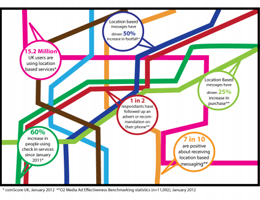
Executive summary
Location Based Advertising can be the most personal form of advertising on a mobile and if used correctly can deliver exceptional results. This report has been created to give advertisers and agencies an insight into the models that are currently being used with some case studies and top tips for using each.
What is Location Based Advertising?
Location Based Advertising (LBA) has been around for years. With the rise of regional and local newspapers in the 19th century there was an influx of advertising which was tailored to your local area. These adverts were relevant, split by sector and some even offered vouchers and coupons which could be cut out to be claimed. Although static they bear a lot of resemblance to what is happening in this space today.
We are all part of a technological revolution – smart phone technology is rapidly growing and the rate of consumer adoption is matching it. It is technology that has driven the capabilities of Location Based Advertising and has opened the door for marketers to use clever techniques to get their brand in front of consumers.
Mobile devices are very personal to the user. It is therefore very important that, with any location-based marketing technique, the privacy of the user is safeguarded at all times. In most cases, the consent of the user will be required and it will be important to determine where this is sought as it may vary between business models. In any case, it is vital that marketers offer users transparency about the location data that is collected and used and ways to control it. The IAB will be developing UK good practice for location-based marketing in 2012.